Disclaimer: The many and varied aspects of ancient Egypt and, in particular, how it relates to the biblical narrative, is a difficult and complex subject. For many years, Creation Ministries International (CMI) has published a range of views by various authors in its publications (CREATION.com, Journal of Creation, Creation Magazine etc.). These views do not necessarily agree with the present views of CMI’s writers on this topic, but remain available online as they form part of CMI’s historical archives of its publications. For a summary of key articles about this subject see our QA section on Egypt.
A Better Model for the Stone Age Part 2
The intention of this discussion is to arrive at a meaningful and realistic archaeological model based on
- the biblical historical model, and
- the archaeological evidence
for a satisfactory explanation of the origin of the nations, general and specific, consistent with all that we know about the so-called Stone Age and the vast number of sites where artifacts are found all across the face of the earth.
Previously we had looked at the inherent principles implicit in a realistic biblical model for the understanding of ‘Stone Age’ cultures.1 The following points are applicable coming naturally from the discussion in part 1, are evident from the biblical statements, or follow logically from known human behaviour:
- The biblical model is an historically valid model.
- An early population of one language - a clear statement of Genesis (Genesis 11).
- A catastrophe affecting this population and causing migration outwards from a central point in all directions available for that movement - a pond ripple effect (discussed in Part 1 and not dissimilar to the concepts of ‘the widening circle’ presented earlier by Custance in ‘Noah’ Three Sons’2)
- Variable rates of spread of different groups with resultant different settling sites.
- SURVIVAL, the determining principle for immediate cultural expression in the new site.
- The further from the original site the group first settles the more basic the original cultural beginning - an expression of hurried migration.
- Cultural luxuries, viz, pottery, metal-working, farming, will only be available for expression when the basic question of survival is settled, but the potential for those expressions is already there from the start.
- As cultures expand, certain pressures will be active to cause cultural interaction and a serial mushrooming effect (which otherwise may be viewed as cultural ‘ages’ rather than interacting contemporary cultures). These are trade, migration and conquest - the mushroom effect.
- Fixation of some cultures in a spiritual and culturally degenerate state over long periods of time, contemporary with other progressive cultures. Here we should clearly differentiate between cultural evolution or development which we freely accept and biological evolution which we reject. This cultural development in no way indicates biological development or organic evolution.
- Cultural developmental regions consistent with the biblical table of nations in Genesis 10, with the whole earth covered by the descendants of the three sons of Noah - Japheth, Shem and Ham - and no-one else.
- A wetter climatic system and quicker sedimentary build-up.
In Part 1 the point was made that the evolutionary model demands vast ages of ‘stone age’ development but the biblical model allows no such period of time, and arguments were presented to vastly shorten the time to accommodate the known facts.
Here we need to look at another area, that of population statistics, to show that only a relatively short time is needed. In fact, considering the population statistics involved, it would be surprising if a greater length of time than the simple biblical model suggests were justified.
Let us commence by looking at the details of the biblical model as seen through the sons of Noah.
Population potential
If we take the Bible’ own figures in Genesis 10 and Genesis 11 and look at the possible statistics that may arise from them, it will become apparent from the mathematics involved that 430 years from the Flood to the time of the birth of Abraham is more than sufficient time to give a vast population on the face of the earth.
Now, Noah survived the Flood and we are told that he was alive for 350 years following the Flood (Genesis 9:28). Similarly his three sons - Shem, Ham and Japheth - also survived the Flood to give rise to a new race of people (Genesis 10) from whom we are all, the Bible claims, descended (Genesis 9:19, 10:32).
When we recall there were three sons of Noah, we must also double the population to take account of their wives, but for the moment, let us deal in terms of the male population as given in Genesis 10. We can double the figure at the end to include also females. The Genesis 10 account only names and gives the number of the sons born to Noah’ three sons
Certain assumptions are necessary. These are:
- That the biblical model is an historically valid model;
- That the confusion at Babel occurred in Peleg’ lifetime about 100 years after the Flood (Genesis 10:25)
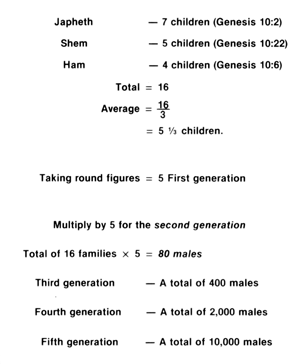
We will also work on the assumption that five male children is the average for each family. Against the Genesis 10 model this is conservative, for we are told that Shem had five sons (chapter 10, verse 22), that Ham had four sons (verse 6) and that Japheth had seven sons. These are the first generation born after the Flood, most likely in the very earliest years. The only details given us in that respect is that Arphaxad was born two years after the Flood. We have then the population of eight people immediately surviving the Flood. The first generation born was 16 male children, but this number could be doubled approximately to 32 to include female children. However, we will start by using the figure 16 as representing the males, the heads of families.
So the first generation of descendants after the Flood was 16 males. (The first was born two years after the Flood in at least one of the three family lines - Genesis 11:10 - so a possible similar timing for the other families is not unlikely.)
For the second generation after the Flood, which would be approximately 30 years later, a total of say 35 years after the Flood, 16 males would give rise to an average of five male children each (approximately) (Figure 1).
Genesis 11:10-24 suggests approximately 30 years for a generation so we could tabulate these figures diagrammatically as in Figure 2.

I am suggesting thus that the fifth generation, though perhaps young new born children at the time of Babel, would be approximately the generation around the time of dispersion. If we add up that figure plus the figures for all the preceding generations who would most likely still be alive (considering the Bible’ claim of longevity in those days). then we would see approximately 12,500 male people alive at the time of Babel (excluding deaths from wars and disease) or a total of around 25,000 human beings (Figure 3).

Using the same parameter (30 years per generation) we come to Abraham’ generation after the Flood and arrive at a figure of at least 31,250,000 males or 62,500,000 people on the earth by the time of the enactment of the story of Genesis 14 in the life of Abraham when the Sumerian and Elamite kings conquered the land of the Jordan and Trans Jordan carving an empire out for themselves.
To demand a much longer period for the ‘Stone Age’ defies statistics. I insist therefore that 430 years from the Flood to the birth of Abraham is a perfectly adequate time for a population of people and for artifacts on the face of the earth of the proportion we find when we discover relics belonging to the so-called Stone Age people from Paleolithic to the end of Chalcolithic. We must also bear in mind that many of these artifacts would actually date contemporary with later periods, so reducing the number actually from the early periods.
These Bible-based population statistics are rarely appreciated by those studying the early history of man. Their magnitude is simply ignored.
Family groups according to the records of Genesis 10 and 11.
If we examine the record of Genesis 11 we note some rather significant statements. After the discussion of the sons of Japheth in verses 2-5 of chapter 10, verse 5 tells us the coastlands were settled by these people into their lands, everyone according to his own language, according to their families, into their nations.
After the discussion of the sons of Ham (verse 6 through to verse 20) we find recorded in verse 20, ‘These were the sons of Ham according to their families, according to their languages. in their lands and in their nations.’
Following the discussion of the sons of Shem (verse 21 through to verse 31) comes this statement - ‘These were the sons of Shem according to their families, according to their languages, in their lands and according to their nations.’
And following this whole summary we are told in verse 32 - ‘These were the families of the sons of Noah according to their generations in their nations and from these the nations were divided on the earth after the Flood.’ Then in chapter 11 verse 9 we are told that the Lord confused the language of all the earth.
Because of the specific statements made in Genesis 10 verses 5, 20 and 31, I believe we can assume that what is given here in the Table of the Nations is a photo start of the broad families, nations and the language groups at the time of Babel immediately after the confusion of languages, the groups from which the nuclear nations came on the face of the earth, the first primary basic nations, and languages.
If that be the case then we may also use these statistics given above for population, to work out what the average size of a family unit or Genesis nation unit at the time of Babel may be.
Family statistics
Japheth
Taking the details of Genesis 10:2-4 we note seven sons of Japheth. But seven sons are mentioned from two of these - thus making the two fathers’ names redundant for statistics. This leaves us with 12 basic family groups descendants from Japheth as depicted in Figure 4.

Now if there were seven males originally born to Japheth and if we assume an average family size of about five males, and we count Japheth himself as generation 0, the fifth generation being approximately 100-125 years after the Flood (in dispersion), and obviously including a significant number of very small children, then we can reach the conclusion using the previous criteria that the total population of the Japhethites in terms of male personages 125 years after the Flood could be 4,375.
Now if we divide that number by the 12 basic family units of the Japhethites then we come to the conclusion that a family unit of the Japhethites just a few years after the dispersion could be as much as 364 males, which represents 4,375 divided by 12.
This obviously would be a high figure, and we would assume that the family unit representing this nuclear nation and this single language would be somewhat less than that. But certainly it could have been around the 300 males. We therefore assume that the total personages, males and females, could easily be 600 people in the early national and language units from the Japhethites very soon after Babel, that is, 600 people per dispersion unit.
Now a family or tribal unit of 600 people could have a significant effect in any region in terms of village culture. So very soon after the dispersion from Babel, we could be dealing with a significant amount of artifactual material wherever the Japhethites moved.
Shem
Similarly using the same idea with the Shemites, we come to the following conclusion. Genesis 10 tells us there were five sons of Shem. Now with the same types of statistics we find that in the fifth generation approximately 125 years after the Flood, there could have been 3,125 male Shemites. The actual number of family and language groups of the Shemites (see Genesis 10) could be interpreted several ways, but let us start with the five-fold division shown in verse 22, namely Elam, Asshur, Arphaxad, Lud and Aram.
We are given four sons of Aram whom we can substitute instead of Aram himself. Arphaxad is followed several generations down to a basic division between Peleg and Joktan. Now as we are told in Genesis 10 verse 25 that it was in Peleg’ day that the earth was divided, we may perhaps assume two families instead of Arphaxad. However, the possibility remains that all the sons of Joktan, the brother of Peleg, may also be seven language groups. But we will use the simplified form here of four sons of Aram as basic tradition, and two descendants of Arphaxad, namely Peleg and Joktan, the others being in themselves in their original form, the basic language groups, namely Elam, Asshur and Lud. So we are left with nine basic units for the sons of Shem (see Figure 5).
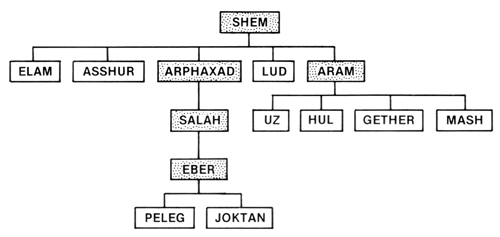
Now dividing 3,125 by nine, we can conclude a family grouping of males among the Shemites of 347, not much different from that which we found for the Japhethites , and thus we would assume that a total population, men and women, would be somewhere around the 600 mark or more.
Ham
Similarly applying the principle to Ham, we find the fifth generation from Ham on the same basis to be approximately 3,750.
However, when we come to the families of Ham again we have a similar difficulty in discerning which unit should be taken as basic. If we assume that all the last mentioned names are basic units, then we are left with the possibility of 25 (or 26) family groups or language groups, all basic national units (see Figure 6).

Dividing 3,750, the figure arrived at for the fifth generation of the Hamites on the assumption of five male children per family, by 25 we get 150, somewhat less than the other two groups. However, there are many assumptions inherent in our calculations, and as much as 300 could well be the case in each unit as it was with the Shemites and the Japhethites. But even so, 150 males in a family unit is not a small size as the Hamitic people seem to be the most diversely separated of all the people mentioned in Genesis. There could well be a greater fragmentation and smaller national units to begin with. To go any further than this is sheer speculation and not a great deal of value.
These statistics provide background to what it is we would be seeking in terms of archaeological details. The very earliest cultures after Babel should number a possible 12 Japhethites, 9 Shemites and 25 Hamite groups, a total of up to 46 initial cultures and languages scattering across the face of the earth. (More than 50% of these groups would be Hamites.) This would multiply as the population expanded.
We should remember that when we are talking here about culture we are referring to specific items such as stone tools, metal artifacts and pottery. Pottery and stone tools themselves are the express pattern of their creator and can vary within a family according to the person who makes it, so that slightly differing cultures may not necessarily represent slightly differing human genetic groups. They may in fact be the same genetic group, or there may be similarities of cross cultures which give a deception of unity where there is no such genetic unity.
Special groups and cultures
Let us now look at the specifics of the biblical model of the origins of nations and languages particularly as seen in Genesis 10 and 11, and at the relevant archaeological material.
Aram
In the days of Abraham, the northern part of Mesopotamia was known as Aram Naharaim, from where Abraham came after living in Harran (Genesis 12), which was the same city to which Abraham dispatched his servant when he sent him to find a wife for Isaac (Genesis 24, particularly verse 10).
In the days of Jacob it was given the name of Padan Aram (Genesis 28:2). In any case it is clear that the northern part of Mesopotamia between the two rivers was occupied by people known as the Aramites. The name comes from Aram (Genesis 10: 22, 23).
Genesis 10 tells us that Aram had four children, and although we are not given any specifics about where these children went, it is clear that the name Aram here has associations with the later Aram, or the Aramites, at least in biblical thought.
Now if we date Babel to approximately 2,200 B.C. (as reasoned by implication from Noah’ Flood 3) and if Abraham came from Mesopotamia (the region of Aram) approximately 1875 B.C., then we would expect that there is archaeological evidence that a people who can fit the description generally of the Aramites should be found well established in this area (see Figure 7).
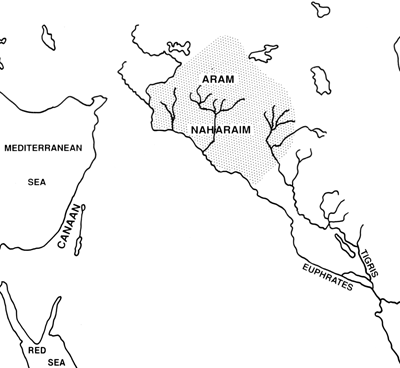
What in fact do we find? Taking the former supposition of the Jemdat Nasr culture being identified with the biblical story of Genesis 14 and the Elamite Chedarloamer,4 we would expect to find some evidence in Aram or northern Mesopotamia of Jemdat Nasr influence, but this would only be the latest of cultural influences in this region superseding and dominant on other cultures.
The dominant culture that had been in this area prior to the Jemdat Nasr period was a culture that is known to the archaeologist as the Halaf culture, named after Tell Halaf where it was first identified. One of the best summaries of our present knowledge of the Halafian culture is found in the publication, ‘The Hilly Flanks’5. It seems clear from the present state of knowledge that the Halaf culture was a fairly extensive culture, but it was mostly dominant in the area that we recognise as Aram Naharaim.
It is found in the following regions. First, its main base in earliest distribution seems to have been the Mosul region. From there it later spread to the Sinjar region to the west, further westward in the Khabur head-waters, further west again to the Balikh River system, and then into the middle Euphrates valley. It also spread a little north of these areas. It influenced areas west of the Middle Euphrates valley and a few sites east of the Tigris River, but as a general statement, in its fully spread condition, the Halaf culture dominated Aram Naharaim (see Figure 8).
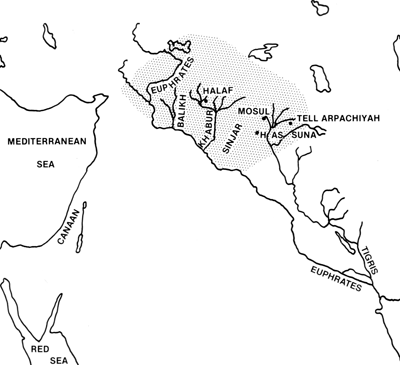
The site of Arpachiyah just west of Nineveh across the Tigris River appears to have been the longest occupied site and perhaps the original settlement of the Halaf people. This and Tepe Gawra were important early Halaf towns.
The settlement of the Halaf people at these cities continued for some considerable time, finally to be replaced by the Al Ubaid people from southern Mesopotamia. When Mallowan excavated the site of Tell Arpachiyah, he found that the top five levels belonged to the Al Ubaid period. The fifth level down had some admixture of Halaf material within it. He says:
‘The more spacious rooms of T.T.5 indicate that it is the work of Tell Halaf builders; that the two stocks did not live together in harmony is shown by the complete change of material in T.T.l-4, where all traces of the older elements had vanished. Nor did any of the burials suggest an overlap between graves of the A ‘Ubaid and Tell Halaf period; on the contrary, there was evidence that in the Al ‘Ubaid cemetery grave- diggers of the Al ‘Ubaid period had deliberately destroyed Tell Halaf house remains.’6
He further comments the following:
‘It is more than probable that the Tell Halaf peoples abandoned the site on the arrival of the newcomers from Babylonia; and with the disappearance of the old element prosperity the site rapidly declined; for, although the newcomers were apparently strong enough to eject the older inhabitants, yet they appear to have been a poor community, already degenerate; their houses were poorly built and meanly planned, their streets no longer cobbled as in the Tell Halaf period and the general appearance of their settlement dirty and poverty stricken in comparison with the cleaner buildings of the healthier northern peoples who were their predecessors.’7
He further says:
‘The invaders had evidently made a wholesale destruction of all standing buildings converted some of them into a cemetery.’8
It is clear from the discussion of Patty Jo Watson9 that the later periods of the Halaf people were found in the other regions, particularly in a westward direction across the whole area of Aram Naharaim, namely the Sinjar region, the Khabur head-waters, the Balikh River system and the middle Euphrates. While the site of Arpachiyah had been destroyed by the Al Ubaid people and the former inhabitants either dispersed or destroyed, it seems clear that the Al Ubaid culture had not been so devastating upon other areas where the Halaf people were but had been assimilated in some way into their culture even though the Al Ubaid culture became dominant later. We find this particularly suggested by Mallowan while discussing findings at Tell Mefesh in the Balikh region (Balih).
He says:
‘The pottery discovered in the house was particularly interesting, although unmistakably of the Al Ubaid period, it revealed certain characteristics of the T. Halaf phase of culture suggesting that the Al Ubaid period occupants at Mefesh were, at all events in their ceramic, considerably influenced by their predecessors.’10
He goes on in speaking of the ceramics by saying:
‘But I believe on grounds of the style of painting and the fabric that this is a hybrid ware, and that it may indicate a fusion on the Balih of the peoples representing the intrusive Al ‘Ubaid culture with those of the older T. Halaf stock. Elsewhere, the evidence generally indicates that with the intrusion of the Al Ubaid peoples, the ceramic of T. Halaf rapidly disappeared but at Tepe Gawra Dr E.A. Speiser indicates that he has found evidence of a pottery representing a fusion of the two cultures and it is possible that when this detailed evidence is finally published, it may tally with that obtained at T. Mefesh.’11(emphasis ours>
So it seems that the culture of Upper Mesopotamia, previously Halaf, became affected by the Al Ubaid culture from the south resulting in a continuous but changed culture, with no doubt an admixture of the population in some way and in some proportion.
I will later attempt to show that the Al Ubaid culture is deeply associated with the name of the Chaldeans, and that the Halaf people were subjected to a northern migration and conquest as evidenced by the presence of southern names (from Southern Mesopotamia) in the north. Such an example may be found at the site of Harran, which represents a southern name and a religion that essentially had its roots in the south, but was in fact a city in the north. This point becomes greafly significant when we come to the migration of Abraham from Ur of the Chaldees in the south up to the city of Harran and finally to Canaan. The way had already been prepared by migration of Chaldean peoples who apparently had attacked the major stronghold of the Halaf peoples in the north (which here I am equating with the Aramites), but finally to dominate them in the Aram Naharaim area culturally at least for some time to come.
There is now no question that the early Halaf people in the north were contemporary with the early Al Ubaid people in the south, here equated with a contemporaneity of the Aramites with the Chaldeans.
Joan Oates discusses this fact:
‘It is quite clear that in the Hamrin at this time there were potters working in both the Halaf and Ubaid traditions, perhaps even side by side in the same villages. Certainly, the contemporaneity of these two very distinctive ceramic styles cannot be in doubt. Such contemporaneity has always seemed a possible explanation of certain chronological anomalies (Oates 1968 p. 1973, p. 176) and is indeed the only explanation that makes sense of the late Halaf ‘intrusion’ at Choga Mami, where the Samarran and early Ubaid materials are very closely related. The modern situation may perhaps provide a relevant parallel in that villages of Arabs, Kurds, Lurs and Turcomans exist side by side, their inhabitants often distinguishable by their dress and other cultural appurtenances. In the Hamrin we have the first unequivocal evidence of such a situation in near Eastern pre-history, where previously we had assumed a ‘chest-of-drawers’ sequence of cultures.’12
There is a need, of course, to show that there was a general continuity of the culture from the days of Halaf in the majority of Aram Naharaim through to at least the days of Jemdat Nasr.
The model here presented is that the biblical descendants of Aram first migrated from Babel in southern Mesopotamia up into the area around Mosul, particularly the major site of Arpachiyah and then spread out into northern Mesopotamia around the headwaters of the Khabur (biblical Chebar) and the Balikh Valleys. There they lived and there they multiplied being, however, influenced by a number of cultures over many centuries, first by the Al Ubaid people (here equated with the Chaldeans of the south), then later, with the Uruk culture (again from the south), together with the Jemdat Nasr influence of Elamite origin in the days of Abraham, whence they can be recognised from the written record of the Bible as the people of Aram Naharaim or Padan Aram.
What number of Aramites may we expect in the area of the Halaf culture? Taking the biblical parameters we would expect about 600 people in the earliest Halaf settlement, perhaps Tell Arpachiyeh, this representing generation five after the Flood. At the end of the ‘Stone Age’ or Chalcolithic period we would expect 1,875,000 people in the Halaf population using parameters previously mentioned; or in round figures somewhat less than two million people (see Figure 9).
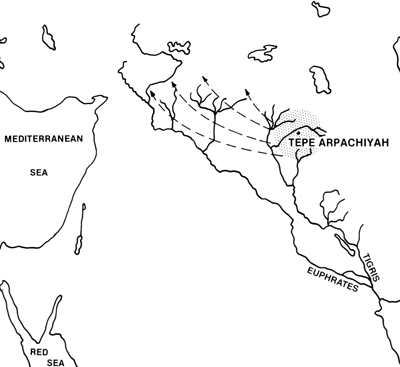
Arphaxad - Al Ubaid, the Early Chaldees
Josephus13 identifies the descendants of Arphaxad as the Chaldeans and this seems to be consistent with the biblical statements concerning them, for Abraham was a descendant of Arphaxad (Genesis 10:24 and 11:10–31). Abraham left Ur of the Chaldees to eventually travel to the land of Canaan.
Now Ur of the Chaldees, that is, the southern Ur found in the region south of the Euphrates River, has been excavated by Woolley. Woolley found that the earliest layers in Ur were built by the Al Ubaid people. (Al Ubaid is the early pottery culture of this region.)
Now if the Al Ubaid people built Ur, then Ur would be an Al Ubaid city originally, and as it was known as Ur of the Chaldees, this allows us to equate the Chaldees with the Al Ubaid people. This fits what we know of the Chaldean people. Certainly, it was in that region of the world that the later Chaldeans were known to live. It is also clear that this area had an influence on the north by the naming of such cities as Harran associated with the same religions that were known in the region of Ur of the Chaldees.
It is certain that Joan Oates has shown the contemporaneity of northern Halaf and southern Ubaid, a fact that bears well with the Table of Nations in Genesis 10.14
The Al Ubaid culture of Southern Mesopotamia was centred around the cities of Ur and Eridu, and its earliest manisfestation, the Hajj Muhammad pottery, appears to be the first culture on the soil of this area of southern Iraq:
‘At all sites so far investigated in the South the Ubaid rests directly on virgin soil, and there seems little doubt that the people who bore this culture were the first settlers on the alluvium of whom we have any trace.’15
From this region at a later epoch came the now famous Nebuchadnezzar II of Babylon, the Chaldean.
Perkins discusses the Ubaid culture, showing firstly a southern and a northern group, each having two phases. She insists the southern two phases are ‘one fabric throughout’16 and after considerable discussion shows the southern and northern cultures to be definitely connected.
‘That connections exist between the north and south is indisputable.’17
She also shows Ubaid I temple VIII at Eridu to be contemporaneous with the Halaf culture of the north.18 The Ubaid culture was southern but mushroomed (via trade, migration and conquest) into the north to become dominant.
‘As the Halaf culture became decadent the Ubaid cultural influence grew stronger, and by the time of Gaura XIX the culture of the North became Ubaid.’19
This brought at least a semblance of Mesopotamian unity not previously witnessed, and not seen again for many years.
‘Not until the spread of the Assyrian Empire was there again a cultural continuum of so great an extent in the Near East.’20

We have identified Abraham’ early years in Canaan previously21 - at the time of the Jemdat Nasr culture of Mesopotamia - when a combine of four kings ruled, including Sumerian (Uruk) and Elamite kings. If our identification is correct, then Terah, Abram and Nahor (from Ur of the Chaldees) travelled in a Mesopotamia which had only recently been unitedly and powerfully influenced north and south by the Al Ubaid/Chaldean people. They were equally at home in southern Ur as in northern Harran (see Figure 10).
Asshur and Samarra - The Early Assyrians
The Bible identifies Nimrod as travelling to the land of ASSHUR (Assyria), and building Nineveh. Without doubt the semitic Assyrians had been a long time in that region of the world when the later Assyrian empire flourished. If the first city of Nineveh was built by Nimrod (from Sumer), into what culture archaeologically did he travel? Without doubt the early geographically related culture at the time of Nineveh’ first and second cities was SAMARRA.
Roux says of its geographic distribution:
‘… it is found only in the Upper Tigris Valley, from Samarra to Nineveh, in Upper Jazirah (Tell Halaf, Tell Chagar Bazar) and at one point of the Euphrates Valley, Baghuz, opposite Abu Kemal’22
And Seton Lloyd comments on the site of Tele-es-Sawwan:
‘Here then was an indigenous manifestation of the hitherto elusive Samarran culture, centred apparently upon the Tigris at the northern extremity of the alluvial plain.’23
This culture was separate from the contemporary Hassuna culture 24, yet contemporary with Ninevite 1 and 2.
‘It is interesting to note, in view of the fact that the excavator seems not to recognize Samarran painted pottery until stratum 2b, that at least three sherds in stratum I bear typically Samarran designs … In 2b the painted pottery is definitely Samarran in type; …’25
Yet Ninevite 1 is definitely distinct from Samarra ware, conforming to the biblical model (see Figure 11).
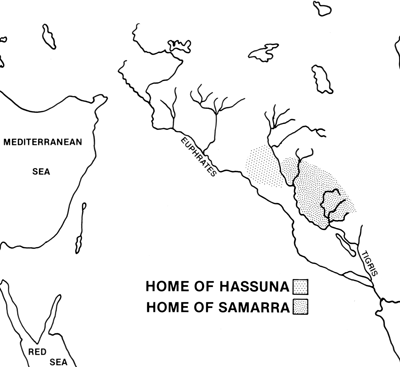
It is here suggested that the above fit requires the Samarran culture to be identified as early Assyrian. It becomes evident that early Ubaid, Samarra, Halaf and Ninevite 1 and 2 are overlapping and contemporary. Such relationships are mentioned by Joan Oates.26 At least part contemporaneity of these cultures must be accepted rather than serial arrangement or ‘chest of drawers’ effect.27 This principle, suggesting succeeding cultures have part contemporaneity, has already been discussed 27 (also see Figure 12).

Sumer and the Uruk Culture - Nimrod
The CITY OF WARKA (Mesopotamian URUK) is clearly identified with biblical Erech. The origin of this city is associated with NIMROD, a grandson of HAM. His descendants are therefore Hamitic (Genesis 10:6-10).
The Scripture tells us that he was associated with the beginning of Babel (Babylon ? Borsippur?) Erech (Uruk-Warka), Accad (in the environs of Babylon ?) and Calneh (not identified) in Shinar or Sumer, which is southern Mesopotamia (see Figure 13).
The Bible does not say that these are the oldest cities, only that they were the beginning of Nimrod’ kingdom. The oldest city that the ancients claim was Eridu - of Ubaid origin (here equated with Chaldea and Arphaxad). Clearly Nimrod’ kingdom was early Sumer and that equates with Sumer of early URUK culture.
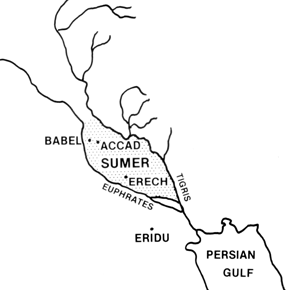
The Scripture indicates that Nimrod himself left Sumer, went into the later Assyrian region and built Nineveh, Rehoboth Ir. Calah, and Resen (Genesis 10), and this region is called ‘the land of Nimrod’ (Micah 5:6). So Sumer and the early Assyrian region should be connected to Nimrod and his descendants, perhaps an early reason for their dual affinity later. I am therefore equating SUMERIANS with the HAMITIC descendants of Nimrod and it should be noted that their features were probably dark skinned - the ‘black headed ones’28.
Of all the Chalcolithic cultures of Mesopotamia two groups fall out naturally on a pottery culture affinity:-
- Ubaid, Halaf, Samara (and Elam) - a similarly painted design pottery; and
- Uruk - monochrome red, and Hassuna.
It is here therefore suggested that this separation is basic and represents:
- Ubaid, Halaf, Samarra - biblical Shemitic (genetics) equals Semitic (not necessarily language)
- Uruk, Hassuna - biblical Hamite
A late Chalcolithic (Uruk/Jemdat Nasr period) King of Sumer would be Amraphel - Genesis 14:1 (possibly also Arioch).
The information available in comparative terms to connect the Nineveh 1 culture and early URUK is little, but if we turn to the biblical model, it seems that a relationship must exist between early URUK and Ninevite 1, and we would expect excavation to eventually confirm this. At present we can only rest with the theory and await further work (see Figure 14).

Certainly Ninevite 1 is contemporary with both Hassuna and Samarra pottery.29
Hassuna and the Canaanites
Relationships with the Hassuna culture are a little easier to define. There is a clear connection of Hassuna pottery with the early pottery of Palestine, and Cilicia, and a skeletal relationship too as Georges Roux has said:
‘Here is therefore positive evidence of a community of culture in the whole area of the ‘Fertile Crescent’ from the Dead Sea to the Tigris with a main focus along the Mediterranean. Moreover, the skulls from Hassuna which have been studied belong, like the skulls of Byblos and of Jericho, to a large toothed variety of the long- headed Mediterranean race’ and suggest an underlying unity of population’30
Bible students will, of course, recognise this area to be the original settlement of the many Canaanite groups mentioned in Scripture. Moreover, Lloyd and Safar in their excavations at Tell Hassuna illustrate the relationships:
‘As for the affinities of the Neolithic coarse ware from Tell Hassuna, it is remarkable that in every case not only the fabric but various types of lugs also are paralleled elsewhere. Coarse ware at the bottom of Schaeffer’ sounding at Ras Shamra (Ugarit V) shows mamelon-lugs near the mouths of vessels, and ‘ledge handles’. In stage two of Jericho IX the straw-tempered ware has ‘knob handles’ just below the rims of vessels. Shipton’ coarser ware in Megiddo XX has knob lugs. Lugs of the ‘nipple’ type occur in the neolithic pottery of Mersin also.’31
It is thus with the Canaanite regions that Lloyd and Safar draw their analogies.
Which group of Canaanites were at Hassuna, if the suggestion is correct, is purely speculative at this stage. But the most easterly Canaanites were the Amorites, and perhaps we should look to them first for our answer.
Elam and the Indus Valley Civilisation
The geography of this region can be divided into three areas:
- The area of ancient Elam - Fars, Khuzistan and parts of Luristan, Kurdistan and Kerman provinces (see Figure 15);
- The Iranian plateau across into Pakistan; and
- The Indus Valley.

This region has naturally been tied into Mesopotamian sequences, which therefore become a guide to the history of the region and especially its western relationships.
Prior to the earliest appearances of man in the Iranian Plateau, there is strong evidence of much residual water and of wet conditions, the sort of conditions we would expect following the great Flood.32
‘Recent geological research has shown that at the time when the greater part of Europe was covered by glaciers, the Iranian Plateau was passing through a pluvial period, during which even the high valleys were under water. The central part of the plateau, today a great salt desert, was then an immense lake or inland sea into which many rivers ran from the high mountains.’33
Ancient Elam
The early pottery of the Susiana area of Khuzistan demonstrates painted ware (dark-painted buff wares) and red and buff plain wares of long indigenous standing.
‘This ceramic group shares shapes, motifs, and manufacturing techniques with the Middle (c.4300–4200 B.C.) and Early (c. 5200–4800 B.C.) Susiana assemblages and represents the culmination of a primarily local craft tradition whose roots can be traced back into the fifth and possibly the sixth millenium B.C.’34
The above wares (Susa I) are to be placed before the Mesopotamian Uruk period.35 If the biblical model of the Origin of Nations is assumed to be the chronological framework, then the Susiana sequence until the end of Susa would be contemporary with the Eridu to Ubaid series of Mesopotamia; itself to be seen contemporary with the Hassuna to northern Ubaid series36 (see Figure 16).

So in the earliest occupation of Susiana by man we are faced with a population which would identify geographically with the genetic Elamites, descendants of ‘Elam’ son of Shem, son of Noah, of Genesis 10.
Moreover, as the genetic stock multiplied, we may reasonably expect a compounding of groups along tribal or family lines (Genesis 10:5, 20, 31) but, at this stage, within the same language group characteristics as the parent Elamites. Such is in fact the case when we consider the early groups who inhabited the region of ancient Elam and the surrounding districts.
‘From south to the north, these were the Elamites, Kassites, the Lullubi, and the Guti. All belonged to the same racial groups; all spoke related languages, and the constant pressure of the plain, which was already organised in civilized kingdoms, forced them all to unite at about the same time though only temporarily.’37
I am therefore suggesting that the early people of Susiana were the biblical ‘Elam’ of Genesis 10, and that they also gave rise to the Kassites, Lullubi, and Guti of Mesopotamian history (see Figure 17).

At the end of Susa I period, equivalent to the beginning of the Uruk period in Mesopotamia, and for the duration of Susa II (Uruk IV), we meet in Iran the monochrome red ware so typical of the Uruk of Mesopotamia. Thus a profound cultural dominance of the Uruk civilisation becomes evident for the whole duration of the Uruk IV and Susa II periods.
As Carter and Stolper state:
‘Thus, both on the specific level of artifact styles and on the general scale of social oganization the Susa II period can be considered the equivalent of the Uruk period in Mesopotamia.’38
The identity of the Susa culture does not apparently disappear, but is certainly profoundly influenced by the dominant Uruk culture which, however, does not give any marked evidence of violent imposition, although some evidence of destruction is present at the beginning of the period.
‘The nature of the transition between period I and period II is still unclear at Susa. Although several phases of destruction, abandonment, and reconstruction of the terrace are found near the end of period I, it is not until later period II that this monumental structure falls into complete ruin.’39
Nevertheless I believe we must assume possible military dominance, considering the profound nature of the cultural change to Uruk-type artifacts.
‘Detailed analyses such as those carried out by Johnson would probably show variations between the Khuzistan and Mesopotamian assemblages. Nevertheless, the closeness of the Susa II and Uruk assemblages is striking.’40
And again:
‘At Susa, painted pottery suddenly stops and is replaced by a monochrome red ware with handle and tubular spout. This also occurs on the Mesopotamion plain, where it is characteristic of the period known as Uruk IV.’41
At the end of Susa II, a resurgence of the indigenous culture occurs, known as the PROTO ELAMITE period, and is particularly characterised by the first appearance of the proto-Elamite script. The early part of this period corresponds to the Jemdat-Nasr period in Mesopotamia, which is also characterised by the appearance of the first indigenous writing of Mesopotamia.
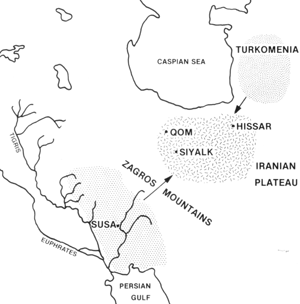
As Ghirshman puts it:
‘Shortly afterwards, during the last centuries before 3000 B.C., a civilization arose at Susa which, though remaining under strong Mesopotamian influence, created its own writing, known as ‘proto-Elamite’, and was contemporary with the Jemdat Nasr period of the neighbouring plain.’42
I have elsewhere argued that this short period must be associated with the first known Elamite ruler, Chedarlaomer, known from the Bible (Genesis 14), and associated with the Sumerian rulers Amraphel (Uruk?) and Arioch (Larsa?). as well as Tidal.43
The fledgeling Elamite-Sumerian confederacy now began to carve out an empire which affected regions as far away as Palestine, Mersin and eastward into the Iranian plateau - to be dated c. 1880-1870 B.C. (see Figure 18).
With the fall of the Jemdat Nasr period, Mesopotamia entered its early dynastic period, and the Proto-Elamite civilisation now expanded into the plateau with a violence which displaced or destroyed the early painted pottery culture of the region Siyalk III.
‘At Siyalk, houses belonging to the end of period III were abandoned and a thick layer of ash shows that they were destroyed by fire.’44 Figure 19. Diagram depicting the possible events with the resurgence of the Elamite culture.
‘The slow and peaceful infiltration in the north east of the Plateau by men using black pottery seems to have been very different from the arrival of the civilization bringing the proto Elamite script, which bears all the marks of brutal conquest.’45(See Figure 19).
Again the population of Elam and surrounds must have had a similar type of number as with Halaf and Ubaid at end of Chalcolithic, that is, approximately 2,000,000.
The biblical Semitic groups
The Hajj Muhammad pottery (early manifestation of Ubaid - here identified as Chaldean) seems to have had a relationship to other Semitic groups.
Georges Roux states that at Eridu:
‘…they contained a painted pottery which, in the opinion of experts, closely resembled the Hajj Muhammad pottery, but was also loosely related to the Halaf and Samarra wares.’46
It does not take much imagination to see that the early Elamite pottery may also have been closely related.
Here we have identified the following:
Halaf ware - Aramite
al Ubaid ware - Chaldean - Arphaxad
Samarran ware - early Assyrian - Asshur
Susa ware - Elamite - Elam
The Bible tells us that the sons of Shem were Elam, Asshur, Arphaxad, Lud and Aram (Genesis 10:22). Only Lud is here unaccounted for archaeologically.
Noah was the Patriarch of all these people, and we are told that he lived 350 years after the Flood (Genesis 9:28). Where was he? Babylonian legend places him in the land of Dilmun (Legend of Gilgamesh). Dilmun was on the island of Bahrain.
The Iranian plateau
The earliest settlement of the plateau has been identified at Siyalk south of Teheran.
In Period I - Evidence of hunting and early farming are apparent, as are also stockbreeding.47 A black smoked pottery, hand-made, is present and with this is a second piece - a red ware with black patches from accidents of firing. Further to this was the introduction of painted pottery (indigenous).
Period II at Siyalk is a more advanced phase of the first. In the ceramics a pottery was introduced with decorations in black paint on the dark red ground.48
The presence of these two phases has been identified mainly on the edge of the great central desert (see Figure 20), at Sivalk, Qumm, Savah, Rayy. and Damgan (Tepe Hissar).

There appeared to be an expansion at the end of Period II to such sites as Giyan. and Tell Bakun westward of the earlier sites; and also across the whole of the Plateau.49 This painted pottery culture flourished, and development occurred in ceramics and the use of metals, but local diversity was evident.
It was during the latter part of Period III that the Uruk influence was evident in the western areas such as Susa, while the Plateau maintained its development. Towards its end, however, two influences were felt; the first a slow infiltration in the north east by a black or grey-black pottery culture, almost certainly by the Turan culture from Turkomenia in southern Russia, and the second a brutal conquest by the Proto-Elamite culture from the area of Susiana, contemporary with the Jemdat-Nasr culture of the Mesopotamian plain.50
For a continuation of the earlier culture of the Plateau we must look to the areas east of the Plateau, towards Pakistan and the Indus Valley, as well as southern Afghanistan. This is not to suggest that the people of these regions were the result of those driven out of Iran, but simply to indicate a cultural affinity with the people of Iran, which may or may not equate with the same racial origins. Mundigak in southern Afghanistan certainly appears to show this affinity from its Period I to Period III (see Figure 21).
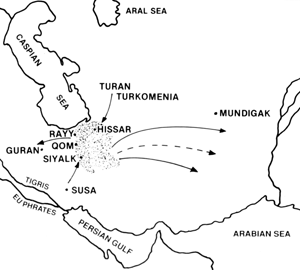
The whole impression of the Mundigak period I assemblage is of closer proximity to sites of Iran:
‘There are numbers of flat stone seals, both square and circular . . . The whole assemblage from period 3 shows many features reminiscent of Siyallc and Hissar, and this too suggests actual contacts with Iran’51
The equation Mundigak III equals Siyalk III (see Figure 22) appears to be a contemporary situation particularly evident in the seals.52 We therefore date the end of Siyalk III and Mundigak III with the Jemdat Nasr period of Mesopotamia. Thus the former ended at about 1900-1850 B.C.
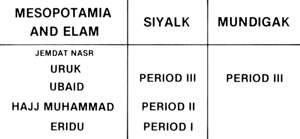
As far as numbers are concerned, we are dealing with more arid geographical conditions and would therefore expect smaller groups of people at any one site, and hence a wider spread of the total population of the plateau. Whether this means that some of the people who settled in the Iranian plateau were part of the same who went to the Indus Valley is yet to be determined, but should be a plausible theory.
Certainly populations appear to have been in both areas simultaneously.
The Indus Valley Civilisation
The evidence has forced the conviction among many archaeologists that the people arrived in the Indus Valley system ultimately from the west. As Allchin and Allchin have said:
‘Somewhere, around the end of the fourth millenium B.C. - the date is hypothetical and as yet attested by no radiocarbon samples - important cultural changes seem to have occurred in the sites of north and central Baluchistan. What these changes signify is not clear, but they may well have involved the arrival of new influences or people from the west. Their interest is emphasized by the fact that they coincided with, and clearly contributed to, the extension of settled life on to the vast plains of the Indus system.’53
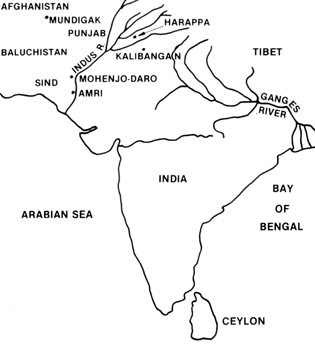
A phenomenon of ‘sloping chronology’ occurs from west to east from the Sumer area to the Indus system. In other words, civilisation was established later as one moves eastward from Sumer to the Indus, a feature we would expect if we were to adopt the biblical model of population dispersion from Babel outwards.
In discussing this phenomenon. Lamberg Karlovsky have this to say:
‘… Thus, as a general observation, it appears that as one moves from west to east the process of urbanization occurs at a slightly later date …’54
They are in fact dealing most particularly with the concept of diffusion of URBAN TRAITS, rather than primary population settlement, and eventually prefer the concept of independent urbanization as a major process, that is, after primary settlement has already occurred, a concept that is perfectly in keeping with the biblical model.
The fact of a sloping chronology however, has deeper ramifications than this, for it is inevitable that such a phenomenon would be somehow evident if the biblical model of diffusion of people outwards from Babel were to be the correct model of the primary settlement of human habitation; and we would assert that herein lies powerful circumstantial evidence for the correctness of that model (see Figures 23 and 24).

Amri Ib appears to be contemporary with the later part of Mundigak III.55 Amri was contemporary with other cultures in the Indus river system, viz. Kalibangan and Harappa are both representative of three sub regions of the Indus civilization.56
These cultures were all pre-Harappan (i.e. the classical Indus River civilization) and represent a contemporaneity with the Chalcolithic of Mesopotamia. Moreover, each of these subcultures show an affinity with the western Baluchistan culture and in fact appear to suggest a Baluchi ancestry, a point totally consistent with the biblical model.57
The pre-Harappan cultures of the Indus River system all show evidence of continuity of cultural traits into the Harappan culture. Although there is evidence of destruction in some sites, as the Harappan culture emerges, the continuity is evident. This also leaves open the possibility that we are dealing with a population which is the same genetically from the pre-Harappan to the Harappan phase, an exceedingly strong possibility given the early days of this culture and the geography of the area.
The Harappan civilization had its own script, which first appears during its classical period and therefore a short time after the appearance of other scripts, such as proto-Elamite in the west. In fact, their emergence may have been, and probably was being, invented by the separate peoples simultaneously (see Figure 25).

This Indus script has been of recent times shown to be, or at least strongly suggested to be, Proto Dravidian; that is the forerunner of the Dravidian scripts of today.58 It was another centre of the multi- centred redevelopment of writing.
The Indus River civilisation was driven out and conquered by the invading Aryans, southward, and its homeland occupied by Aryran speakers. Likewise in India today the Aryan languages (e.g. Hindi) are mainly in the north and the Dravidian languages (e.g. Tamil) are mostly in the south (see Figure 26).

To what genetic origin do we owe the Iranian plateau people of these times and the Indus Valley peoples? We must admit that there is at present no certain identification of origin, but the following facts may help:
- They moved eastward probably from the Mesopotamian area.
- The Iranian Plateau and Indus Valley had a cultural affinity.
- The Indus Valley people had a separate script from the Elamites and it came into prominence a little later.
- The Indus people were apparently dark skinned.
We may provisionally theorise that they were not Shemites - no connection can be made. The skin colour would suggest Hamites, but after that the trail becomes much more speculative.
Conclusion
We have examined the possible population statistics which would correspond to the biblical interval from the Flood until the days of Abraham’ entry into Canaan (approximately 400-450 years). We have found that an interval of no greater length would be required to explain the populations and cultures known to the archaeologists today as belonging to the ‘Stone Age’.
We have examined briefly some of the Mesopotamian cultures against the background of biblical national groups and then extended the investigation into Iran and the Indus Valley.
The following is concluded:
SAMARRA culture = early ASSHUR (Assyria) - Shemite
HALAF culture = early ARAM (Syria) - Shemite
AL-UBAID culture = early ARPHAXAD (Chaldean) - Shemite
SUSIANA culture = early ELAM (Elamites, later Kassites, Lullubi, and Guti) - Shemite
IRANIAN PLATEAU and INDUS VALLEY - unknown but probably Hamite
The discussion aims only to elucidate until the end of the Mesopotamian Chalcolithic and its time equivalent.
As a consequence of the previous arguments, we need to finally consider the dating of the Mesopotamian Chalcolithic. In order to arrive at dates for the Mesopotamian Chalcolithic the following is relevant:
- All cultures outside of lower Mesopotamia should be POST Babel, that is, after 2,200 B.C.59
- We have reasoned before that Jemdat Nasr should end 1870 B.C.60
- Some of the earliest southern sites may predate 2,200 B.C. by a few years.
- Jemdat Nasr may be the lifetime of one king - Chedarlaomer.
- We need to be reminded of the short length of life of mud brick houses when we determine stratification dates.60
Consequently we can draw a table and divide it accordingly with the dates (see Figure 27).
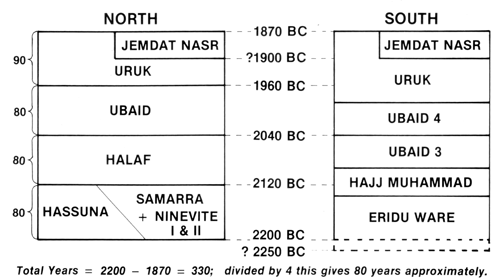
References
- Osgood, A.J.M., 1986. A better model for the Stone Age. EN Tech. J., 2:88-102. Return.
- Custance, A., 1975. >Noah’ Three Sons, Zondervan, Grand Rapids, Michigan. Return.
- Osgood, A.J.M., 1981. The date of Noah’ Flood. Ex Nihilo, 4(1):10-1. Return.
- Osgood, Ref. 1. Return.
- Watson Patty J., 1982. The Hilly Flanks, The Oriental Institute of Chicago, University of Chicago Press, pp.231-249. Return.
- Mallowan, MEL.. 1933. Excavations at Tell Arpachiyah. Iraq, 2(1):13. Return.
- Mallowan, Ref.6, p. 14. . Return.
- Mallowan, Ref.7. Return.
- Watson, Ref. 5. Return.
- Mallowan, M.E.L., 1938. Excavations in the Balih Valley. Iraq 8:128. Return.
- Mallowan, Ref. 10. Return.
- Oates, Joan, 1983. The Hilly Flanks, The Oriental Institute of Chicago, University of Chicago Press, p.254. Return.
- Josephus,. Antiquities, Book 1. Chapter 7. Return.
- Oates. Ref. 12. Return.
- Perkins. A.L., 1977. The Comparative Archaeology of Early Mesopotamia, The Oriental Institute of Chicago. University of Chicago Press, p.73. Return.
- Perkins, Ref. 15, p.82. Return.
- Perkins. Ref. 15, p.94. Return.
- Perkins, Ref. 15, p.95. Return.
- Perkins, Ref. 15, p.96. Return.
- Perkins, Ref. 19. Return.
- Osgood, A.J.M., 1986. The times of Abraham. EN Tech. J., 2:77-87. Return.
- Ronx, Georges. 1969. Ancient Iraq, Pelican, Suffolk, U.K., p. 68. Return.
- Lloyd, Seton, 1978. The Archaeology of Mesopotamia, Thames and Hudson, p.72. Return.
- Lloyd, Ref. 23, p. 73. Return.
- Perkins, Ref. 15, p.9. Return.
- Oates, Ref. 12, pp. 256, 260. Return.
- Oates, Ref. 12, p. 262. Return.
- Osgood, Ref. 1. Return.
- Lloyd, S., and Safar, F., 1945. Tell Hassuna. Journal of Near Eastern Studies. 4:256-261. Return.
- Roux, Ref. 22, p.62. Return.
- Lloyd and Safar, Ref. 29, p.6. Return.
- Osgood, Ref. 1. Return.
- Ghirshman. R., 1965. Iran, Pelican, Suffolk. p.27. Return.
- Carter. E., and Stolper, M.W., 1984. Elam, University of California Publications, p. 12. Return.
- Carter and Stolper, Ref. 34. p. 113. Return.
- Osgood, Ref. 1. Return.
- Ghirshman, Ref. 33, pp. 50–5. Return.
- Carter and Stolper. Ref. 34, p. 114. Return.
- Carter and Stolper, Ref. 34, pp. 112–113. Return.
- Carter and Stolper, Ref. 34, p. 113. Return.
- Ghirshman, Ref. 33, p.45. Return.
- Ghirshman, Ref. 41. Return.
- Osgood, Ref. 21. Return.
- Ghirshman, Ref. 33, p. 46. Return.
- Ghirshman, Ref. 33, pp. 46–47. Return.
- Roux, Ref. 22. Return.
- Ghirshman, Ref. 33, p. 29. Return.
- Ghirshman. Ref. 33, p. 33. Return.
- Ghirshman. Ref. 33, p. 42. Return.
- Ghirshman, Ref. 33, pp. 44–45. Return.
- Allchin, Bridget, and Allchin, Raymond, 1968. The Birth of Indian Civilization, Pelican, pp. 105–106. Return.
- Allchin and Allchin, Ref. 51, p. 110, Fig. 17, compare with Ghirshman, Ref. 33, p. 41, Fig. 14. Return.
- Allchin and Allchin, Ref. 51, pp. 105–106. Return.
- Lamherg-Karlovsky, C.C., 1982. Harappan Civilization, Aris and Phillips Warminster, England, pp.64–65. Return.
- Allchin and Allchin, Ref. 51, p. 117. Return.
- Allchin and Allchin, Ref. 51, pp. 122–123. Return.
- Allchin and Allchin, Ref. 51, p.124. Return.
- Clauson, G., and Chadwick. J., 1969. The Indus script deciphered. Antiquity. XLIII: 200–207. Return.
- Osgood. A.J.M., 1984. The times of the judges - a chronology. EN Tech.J., 1:141–158. Return.
- Osgood, Ref. 21. Return.

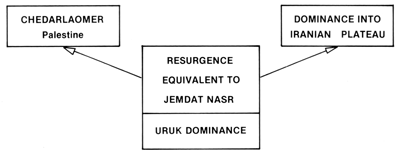
Readers’ comments
Comments are automatically closed 14 days after publication.